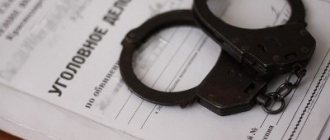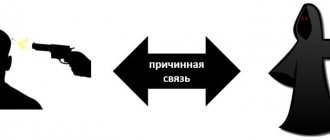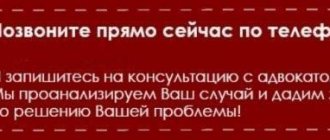A crime is a socially dangerous act committed by a subject under the Criminal Code of the Russian Federation. The law provides for criminal liability for such an offense. The Code determines for what acts the subjects who commit them are punished.
To investigate a crime, it is important to determine its nature - completed or unfinished. However, what is important here is not just the presence of all the necessary signs. A person’s idea of the final result of an action plays a significant role: whether the socially dangerous acts that were intended were realized and whether the desired consequences occurred.
Based on this, it is worth turning to the classification of the crime depending on the content of the objective side. That is, in this way it is possible to highlight the moment of the end of criminal actions. So, there are formal, material, truncated elements of the crime.
Each of these types has its own significance in criminal law, so it is necessary to consider all options in detail. Many scientists are inclined to think that there are only two main types - formal and material elements of a crime. They claim that the truncated one is a variation of the first and will not exist as an independent one.
Formal elements of the crime: how to determine?
A crime with a formal composition is understood as a type of offense that provides that it will be completed from the moment when a socially dangerous act is committed. That is, the necessary characteristics do not include causation and consequences.
So, the object of such a crime does not differ from the objects of material or truncated elements. That is, these are the same social relations protected by criminal law. Liability is provided for causing specific harm or creating a threat of causing it.
As for the subject, it also does not differ from the other elements of the crime. This is the same individual who commits an offense at the age at which criminal liability begins in accordance with the Criminal Code of the Russian Federation.
There are also other signs of a formal crime. These include the objective and subjective side. It is in these categories that the main differences between this composition and the rest are contained.
Elements of criminal composition
To determine the formal or material composition of a violation of the law, it is necessary to know the basic elements of the modern legal industry. At the moment, the Code of Criminal Procedure of the Russian Federation identifies the following elements of the committed violation:
- The object of each punishable crime committed is a special form of legal relations that the criminal person encroaches on. In certain situations, an additional sign is the subject of a violation of the law. Usually no one encroaches on it, unlike the object. He is actually present.
- The objective side is distinguished by the presence of an act dangerous to society, the presence of a cause and the ensuing results. It is here that special optional signs of violation appear - territorial location, period down to hours, motives and general circumstances.
- The subject of the violation is a capable, sane person of the age category from 18, and in some cases from 16 years.
- A special subjective side is the fact and level of a person’s guilt. This criterion is manifested in the presence of prior intent on the part of the offender. Sometimes this includes an action performed due to negligence.
Based on the listed criteria, it is possible to easily identify several categories of possible criminal offenses.
Objective and subjective side of the formal corpus delicti
The objective side is determined by the external manifestations of a socially dangerous attack. The formal and truncated elements of the crime differ in that in the first it is the commission of criminal acts (or inaction) that is punishable. The occurrence of certain criminal consequences is not required. It turns out that the criminal performs all the actions that he wanted, which means that the crime is considered completed without causing any harm dangerous to the public.
Practice has shown that a larger percentage of formal crimes are committed with direct intent. It is generally accepted that the commission of such an offense cannot be careless, because it requires a specific subjective attitude to the upcoming consequences. If they do not occur, the guilty person will not be held accountable in accordance with the Criminal Code. In such a situation, the punishment will be determined by administrative law.
Composition of a violation of the law - what is it?
The composition of a crime committed against a person or society is a criminal legal category of research of the Criminal Code of the Russian Federation.
In legal terms, the composition is presented as a combination of several subjective and objective characteristic features. They define the essence of a recorded social act dangerous to humanity.
Without exception, all signs of a committed criminal act are enshrined in a special act and distributed by industry in the modern Criminal Code of the Russian Federation. The characteristic features are described in different forms of law, part of the general and special part of the Code adopted in the UP.
The characteristic signs of a criminal act can be divided among themselves according to their direct affiliation with a specific element of an act dangerous to society. The following signs of any committed criminal violation of the law are noted:
- An object.
- Subject.
- Objective side.
- Subjective side.
Formal elements of the crime: examples
In order to more clearly consider this type of crime, it is necessary to rely on specific examples.
So, having analyzed Art. 139 of the Criminal Code, we can say that the violation of the inviolability of the home, according to the above, is completed from the moment when illegal entry into the premises directly occurred, committed against the will of the person who lives in it. In this case, the legislator did not include a socially dangerous criminal consequence as a mandatory feature in the disposition of the article. Although it comes here as moral damage.
Also, the formal corpus delicti extends to high treason, extortion, rape, and taking a bribe.
Video lesson “Subject of the crime”
Special subject
A special subject of a crime is a subject who, in addition to the main characteristics listed above, has additional ones.
And these additional signs are directly indicated in the disposition of the corresponding article of the Special Part of the Criminal Code of the Russian Federation. For example:
The characteristics of a special subject are determined:
- Official position (Articles 204, 290 of the Criminal Code of the Russian Federation).
- Family connection with the victim (Articles 106, 157 of the Criminal Code of the Russian Federation).
- Citizenship (Article 275 of the Criminal Code of the Russian Federation).
- Attitude to military service (Articles 336, 337 of the Criminal Code of the Russian Federation).
The absence of signs of a special subject established by a specific article of the Criminal Code of the Russian Federation in a person excludes criminal liability under this article.
Note! A person possessing the characteristics of a special actor may be held criminally liable for organizing, instigating or assisting if he performed a relevant role.
Read more about this in our article “Qualification of crimes committed by complicity.”
ConsultantPlus will tell you in more detail about the special subject of the crime. If you don't have access to the system yet, get it for 2 days free of charge.
Mixing elements of crime
There are cases when the legislator in one composition provides for liability as a completed crime only if two conditions are met: a socially dangerous act has been committed and consequences have occurred.
For example, let's take Art. 258 of the Criminal Code. This article provides for liability for illegal hunting if it is committed: causing great damage; using a mechanical vehicle or aircraft, explosives, gases or other methods for the mass destruction of animals and birds; regarding animals and birds that are prohibited by law from hunting; in a natural area protected by law, in an emergency or environmental disaster zone. Such a composition by design is called the material and formal composition of the crime.
Crimes with material content
This is a crime in which the crime is completed from the moment when socially dangerous consequences occur. That is, consequences are a mandatory condition, without which the offense committed will be interpreted differently.
Crimes with material elements include, for example, murder, theft, bodily harm of varying degrees, fraud, and more.
Subjective side
The subjective side is the mental attitude of a person to the committed act.
So, if the subject is the person who committed the crime, then the subjective side is what happens in his head in connection with the crime. That is, thoughts, intentions, desires, awareness of possible consequences.
Mandatory attribute
The subjective side of a crime has only one obligatory sign - guilt.
Guilt is an intellectual, that is, a person’s internal attitude towards the act committed and its consequences.
Attention! It is not a question of whether a person considers himself guilty of a crime or not. We are talking about a person’s awareness of the possible consequences of his act and his attitude towards them - whether he wanted them to happen, did not want them, or hoped that they would not happen.
Wine can take two forms, each of which is divided into two types:
Now more about each form of guilt.
Direct intent
The person is aware of the possibility of socially dangerous consequences and desires their occurrence.
For example: a person picks up a gun and shoots another person. At the same time, he understands that he can cause death and wants exactly this. Death is coming.
This is murder committed with direct intent.
Indirect intent
The person is aware of the possibility of socially dangerous consequences and is indifferent to this.
For example: a man picks up a gun and shoots at random towards a group of people. At the same time, he understands that he can cause death, admits such a consequence, but is indifferent to this. That is, the shooter’s ultimate goal is different - for example, to scare. But he does not rule out causing death. The bullet reaches its target, death occurs.
This is murder committed with indirect intent.
Carelessness in the form of frivolity
The person is aware of the possibility of socially dangerous consequences, but without any reason expects to prevent them.
For example: a driver gets behind the wheel while intoxicated. He understands perfectly well what consequences this can entail: in a state of altered consciousness, it is not easy to cope with the controls. The result can be more than sad. What does the driver think about this? That's right: “maybe it will blow by.” If it doesn’t go through, there is a collision with a pedestrian, and the pedestrian dies.
This is causing death by negligence in the form of frivolity.
Note! In this case, Art. 109 of the Criminal Code of the Russian Federation (causing death by negligence), and Art. 264 of the Criminal Code of the Russian Federation - violation of traffic rules, resulting in the death of a person through negligence. That is, a special rule in relation to Art. 109 of the Criminal Code of the Russian Federation.
You studied general and special rules of law, as well as the procedure for their application, as part of the TGP course. We advise you to refresh your knowledge and read in “ConsultantPlus” about how special rules of law are applied. If you don't have access to the system yet, you can get it for 2 days for free. Or order the current price list to purchase permanent access.
Negligence in the form of negligence
The person is not aware of the possibility of socially dangerous consequences, but due to the circumstances of the case he could and should have been aware of this possibility.
For example: a girl stands on the edge of the roof of a high-rise building and surveys the surroundings. Wanting to joke and not thinking about the consequences, the young man quietly sneaks up from behind and scares the girl. The girl leans forward in surprise and falls from the roof. Death comes.
This is causing death through negligence in the form of negligence.
Crimes with two forms of guilt
The Criminal Code of the Russian Federation contains crimes that involve both forms of guilt at once - intent in relation to the act and carelessness in relation to the consequences.
For example, part 3 of Art. 123 CC:
An abortion is performed intentionally, but the consequences in the form of death or serious harm to health occur due to negligence.
Such crimes are equated to intentional ones.
This information is useful for determining the category of crime, since it depends, among other things, on the form of guilt, for determining the presence or absence of recidivism, and for choosing the type of correctional institution for the convicted person.
Details can be found in ConsultantPlus. If you don't have access to the system yet, get it for 2 days free of charge.
Optional characteristics
There are only two of them:
- Motive (why the crime is committed):
- self-interest (thirst for profit);
- jealousy;
- hooligan urges;
- compassion;
- misunderstood interests of the service.
- Purpose (why the crime is completed):
- enrichment;
- elimination of a competitor.
Often motive and purpose can be qualifying features of a crime. For example, part 2 of Art. 105 of the Criminal Code of the Russian Federation:
Crimes with a truncated composition
This is a crime in which the offense is considered completed from the moment of preliminary criminal activity, that is, at the stage of preparation or attempt. The definition immediately makes it clear why the formal and truncated elements of the crime are combined into one. Because in both cases there are no consequences as a mandatory feature.
Crimes with formal elements include, for example, encroachment on the life of a statesman or public figure, robbery, the formation of a criminal organization, banditry, and others.
Common and distinctive features
Along the way, we found out that the formal and material elements of a crime are types that have common objects and subjects, but the objective and subjective sides are completely different. They have different mandatory characteristics of these sides, so it is quite difficult to confuse these two types.
As for the truncated composition, it also has common features with the formal and material. They are united by social relations protected by law and the individual committing the crime. However, the objective side of this offense has common features with only one. This has been mentioned several times above - the formal corpus delicti does not define the consequences as a mandatory feature, as in the truncated one.
What's different? For the formal one, it is enough to commit criminal acts, but for the truncated one, preliminary criminal activity is important.
What is pre-criminal activity?
This category includes preparation for a crime and attempted crime. These acts are called pre-criminal activity because they precede the completed offense. It is when they are not absorbed by the completed crime that they have criminal legal significance.
Preparation is acts that are aimed at creating the necessary conditions for the commission of a crime in the future by a certain person, but are not brought to the desired result for reasons that do not depend on the will of a particular person.
Attempt is the actions of a person that are aimed directly at committing an offense, but are not completed due to circumstances beyond his control.
These stages define the crime as unfinished.









